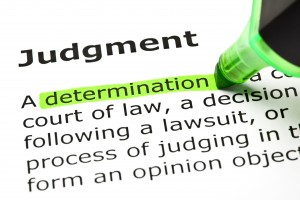By Ryan C. Wood
On May 28, 2012, I first wrote an article about Jamal Lewis’ Chapter 11 bankruptcy filing in the Bankruptcy Court for the Northern District of Georgia, Bankruptcy Case Number 12-58938. Unfortunately since then Mr. Lewis’ case has taken a turn for the worse. Mr. Lewis filed the Chapter 11 reorganization case on April 3, 2012. On August 8, 2012, the case was unfortunately converted to Chapter 7, which means liquidation, not reorganization. In Chapter 11 reorganizations it is possible for a person or company with a fair amount of assets or income to reorganize their debts and come out in good shape and still be considered rich by a normal person’s standard. Chapter 7 means liquidation where only a limited amount of the bankruptcy filer’s assets can be protected and the rest are liquidated for the benefit of the people or companies that are owed money. I of course do not know every intimate detail, but it begs the question why did Jamal Lewis’ bankruptcy attorneys file a Chapter 11 reorganization case to begin with when the case was converted to Chapter 7 only four months after it was filed? It appears the reorganization never had a chance. The filing fee and process or reorganizing is extremely expensive in a Chapter 11 case. Especially a case like this one that has sharks circling it to shred it to pieces. As this article examines this case in detail you will discover how difficult it can be to seek a discharge of debts.
Various Parties And General Information About Filing A Bankruptcy Case
1. United States Trustees Office
First and foremost there is the United States Trustee’s Office or the UST, which is part of the Department of Justice. The UST is responsible for overseeing the administration of bankruptcy cases and the private trustees assigned to Chapter 7 and 13 cases pursuant to 11. U.S.C. §586. When a Chapter 11 reorganization case is filed it is assigned to an attorney within the UST’s office to oversee the reorganization. The UST does not take possession or have a right to possession of the assets of the bankruptcy estate though. This is a key difference regarding Chapter 9, 11 or 12 bankruptcy cases. The debtor, or bankruptcy filer, is a debtor-in-possession or DIP. This means the bankruptcy filer is in possession of the assets of the bankruptcy estate. The DIP must obtain court approval to spend assets of the bankruptcy estate to continue to operate a business or fund an individual’s ongoing living expenses. Some critics of this process ask why is the bankruptcy law allowing the assets of the bankruptcy estate to be left and continued to be managed by the entity or person who theoretically caused or contributed to the financial problems to begin with? Arguably the bankruptcy filer whether a person or a company is still has the most knowledge and in the best position to manage the day to day affairs and assets that are part of the bankruptcy estate. Also, the United States Trustee, Bankruptcy Court, Debtor’s attorney and creditors all monitor the use and preservation of property of the estate for the benefit of creditors. Creditors are much more likely to be active or participate in a Chapter 11 reorganization then a Chapter 13 reorganization.
2. Creditors
Creditors are defined by 11 U.S.C. §101(10) which provides that creditors means an entity that has a claim against the debtor that arose at the time of or before the order for relief concerning the debtor; entity that has a claim against the estate of the kind specified in section 348(d), 502(f), 502(h) or 502(i) of this title; or entity that has a community claim. Any further explanation and digging into the Bankruptcy Code sections listed here is beyond the scope of this article. Basically creditors are those who are owed money or have a claim for money at the time the bankruptcy case is filed or when the case is converted to another chapter of the Bankruptcy Code. Creditors can attend the meeting of creditors and ask questions of the debtor, file objections to confirmation/approval of the plan of reorganization, seek relief from stay to protect their collateral or even file an adversary proceeding to object to the discharge of the debtor or the dischargeability of the debt or claim owed. Mr. Lewis’ bankruptcy case involves all of the above.
3. 11 U.S.C. §341 Meeting of Creditors and Equity Holder
This section of the bankruptcy code requires that a meeting be held that gives creditors an opportunity to ask questions about the income, expenses, assets and bankruptcy petition filed by the person or entity that filed for bankruptcy protection. Depending upon the circumstances no creditors may choose to attend. If so, then the trustee assigned to the case asks the debtor or responsible individual for a business, questions about the bankruptcy petition, their assets and income to verify information in the bankruptcy petition.
4. Filing a Proof of Claim
For a creditor to be paid money from the bankruptcy estate, if any, the creditor must file a proof of the amount they were owed by the debtor at the time the bankruptcy case was filed. A properly filed proof of claim will include documentation of why the creditor is entitled to be paid and how the amount of the claim was calculated. Federal Rule of Bankruptcy Procedure 3001 provides the required form and content of a valid claim. A proof of claim executed and filed in accordance with the rules shall constitute prima facie evidence of the validity and amount of the claim. If a debtor disagrees with how a claim is calculate an objection to the proof of claim can be filed. The amount of an allowed claim can mean the difference in a plan of reorganization being financially possible or not. Objecting to improperly or invalid proofs of claims filed is an important part of most reorganizations.
5. Unsecured Creditors Committee Counsel
If a Chapter 11 reorganization case is filed with hundreds of creditors there most likely will be the formation of a general unsecured creditors committee and an attorney appointed to represent all the interests of the unsecured creditors. The general unsecured creditors committee is usually comprised of the largest unsecured claim holders and the general unsecured creditors committee counsel is paid from property of the bankruptcy estate just like the attorney for the debtor. It is inefficient for each unsecured creditor to hire and pay individual attorneys to represent their interests. All general unsecured creditors share from the same pool of money, if any, so it is much more efficient to form a committee and pay one attorney to fight on their behalf.
6. Chapter 7 Trustee
When a Chapter 7 case is filed or converted to Chapter 7 from another chapter a Chapter 7 Trustee is assigned to administer the bankruptcy estate that is created. Chapter 7 trustees are independent contractors hired by the United States Trustee’s Office. Chapter 7 trustees are paid from the filing fee paid to file bankruptcy and a percentage of any assets paid out of the bankruptcy estate for the benefit of creditors. As of the writing of this article the percentages Chapter 7 trustees are paid when distributing assets to creditors are as follows: 25 percent on the first $5,000 or less, 10 percent on any amount in excess of $5,000 but not in excess of $50,000, 5 percent on any amount in excess of $50,000 but not in excess of $1,000,000, and reasonable compensation not to exceed 3 percent of such moneys in excess of $1,000,000, upon all moneys disbursed or turned over in the case by the trustee to parties in interest, excluding the debtor, but including holders of secured claims.
Why Was The Lewis Case Converted From Chapter 11 to Chapter 7?
There could be many reasons. According to the United States Trustee’s May 4, 2012, motion to dismiss, Mr. Lewis failed to file the mandatory documents pursuant to the United States Trustee’s Operating Guidelines and Reporting Requirements. Mr. Lewis and his bankruptcy lawyer also failed to appear for the Initial Debtor Interview. When filing a Chapter 11 reorganization case there are strict reporting guidelines regarding the monthly income and assets of the bankruptcy filer. The debtor is in possession and control of the assets of the bankruptcy estate, and therefore must provide records of what is taking place regarding the income and assets after the Chapter 11 reorganization case is filed.
After the 341 Hearing It Is Clear Why This Reorganization Case Was Converted To Chapter 7 So Quickly
The United States Trustee filed a supplemental motion to dismiss the case or convert the case to Chapter 7 on June 28, 2012, and the motion paints a much clearer picture as to why this case was converted to Chapter 7 liquidation so quickly. The motion provides excerpts from Mr. Lewis’ testimony at the meeting of the creditors. Mr. Lewis’ schedules listed $14,455,854 in assets with the majority of the value coming from JLew Financial, LLC ($6 million) and Grand Empire, LLC ($5 million). Mr. Lewis testified under penalty of perjury at the meeting of the creditors that the value of his interest in both of these limited liability companies was overstated in the schedules and the values are actually much less. Mr. Lewis’ Schedule D (Secured Debts) included claims exceeding $30 million and Schedule F (General Unsecured Claims) listed claims totaling $871,840.78. The UST believed the unsecured debts listed were much, much more. The Internal Revenue Service filed a claim listing unsecured priority debt owed to the IRS totaling $2,155,829.22 and a claim listing a general unsecured claim totaling $172,590.45. Mr. Lewis’ schedules listed the amount owed to Georgia Department of Revenue as $0.00, but the Georgia Department of Revenue filed a mostly priority tax debt claim totaling $1,619,742.41. So basically Mr. Lewis’ assets were actually far less than represented and his debts were far more than represented. To make matters worse Mr. Lewis testified that his income was far less than was his petition listed of $35,000 per month. The two most common ways to reorganize debts are either to make it happen through your income or sale of your assets. So that is that. No assets and no income with over $30 million in secured debt with collateral to be foreclosed on or repossessed and $3,775,571.60 in unsecured priority tax debt that is not dischargeable. The feasibility or possibility of a successful reorganization of Mr. Lewis’ debts is extremely low if not arguably impossible given these asset, income and debt figures. Therefore, after a mere four months after filing a Chapter 11 reorganization case Mr. Lewis’ consented to his case being converted to a Chapter 7 liquidation of this assets.
It is really difficult to speculate as to why Mr. Lewis filed a Chapter 11 case under his financial circumstances. The possibilities range anywhere from not wanting to believe he is going to basically lose it all by filing a Chapter 7 case to begin with, or misinformation about the process or the possible outcomes. From the outside looking in it is very easy to make assumptions and point fingers about what took place and why. The only real way to know the truth is if you were in the room when Mr. Lewis and his bankruptcy attorneys discussed his options, what to do about it and when. Part II of this article sheds light on Mr. Lewis’ case now that it is converted to a case under Chapter 7 of the Bankruptcy Code and the addition of the Chapter 7 trustee.



